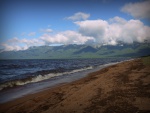Lake Baikal
Lake Baikal in south-east Siberia, the deepest lake in the world at 1,700 m, contains 20% of all fresh running water on the planet, making it the single largest reservoir. The lake contains an outstanding variety of endemic flora and fauna, of exceptional value to evolutionary science. It is also surrounded by a system of protected areas that have high scenic and other natural values. The basin supports a variety of plant and animal species, a number being endemic; the most notable of which is the Baikal seal, a uniquely freshwater species. The great variety of plants in the basin is determined by its climatic asymmetry: the western part is occupied by light coniferous forests and mountain steppes; in the eastern part pine forests predominate; and the north is covered by deciduous forests. The formation of the geological structures in the basin took place during the Palaeozoic, Mesozoic and Cenozoic eras and there are a number of significant geological features. Various tectonic forces are still ongoing, as evidenced in recent thermal vents in the depths of the lake.The lake itself is the centrepiece of the site and its largely unseen underwater features are the core of its value to both science and conservation. Baikal is one of the most biodiverse lakes on Earth, with 1,340 species of animal (745 endemic) and 570 species of plant (150 endemic). In the forests surrounding the lake there are an additional 10 threatened species along with the full complement of typical boreal species. The evolution of aquatic life that has taken place over this long period has resulted in an exceptionally unique and endemic fauna and flora. As the 'Galápagos of Russia', the lake is of exceptional value to evolutionary science.
The landscape surrounding the lake basin, with its mountains, boreal forests, tundra, lakes, islands and steppes, is exceptionally picturesque. The Baikal region has some 1,200 historical, archaeological and cultural monuments of which 1,000 have state protection. A number of these are considered sacred. There is also a mix of distinctive cultures in the region and an interesting human history.
However, there are serious threats to the biotic communities at Lake Baikal and there is a danger that its unique ecosystem properties could be lost. Various steps are being taken to address these issues of integrity with strong support from all levels of government and the Russian public.
Source: UNESCO/CLT/WHC





